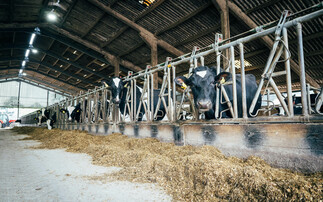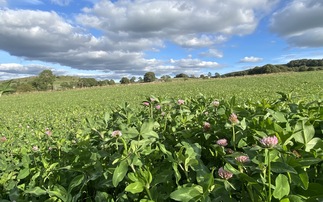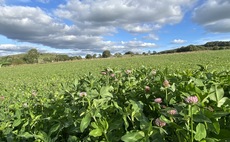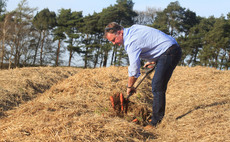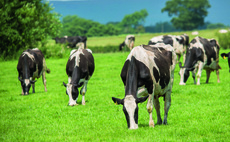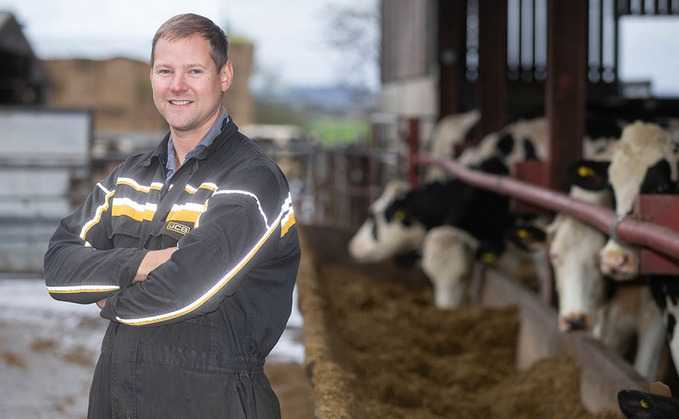
Growing lucerne to reduce reliance on bought-in protein is part of one Leicestershire farm's strategy to create a more sustainable farming system.
Reducing costs by producing more home home-grown feed and hitting good yields with strong milk constituents has been the driving force for Ben Stroud since he returned to the home farm six years ago.
Since then, he has focused on improving forage quality, growing lucerne as a home-grown protein source and making better use of mucks and slurries.
The move to lucerne has delivered a £1,420 per month saving in feed costs thanks to reduced soya inclusion.
At the same time, targeted use of slurries to deliver phosphate (P) and potash (K) to the fields which need it - based on soil analysis - has saved £10,000 a year in bought-in fertiliser costs.
This should help reduce the farm's environmental footprint and increase business resilience.
Mr Stroud says it ultimately comes down to margin, and by lowering costs and pushing performance, that is what he is delivering.
He says: "I am keen to reduce our reliance on bought-in feed.
There are two areas of attention for that - producing quality grass silage and growing our own protein.
That is where lucerne comes in."
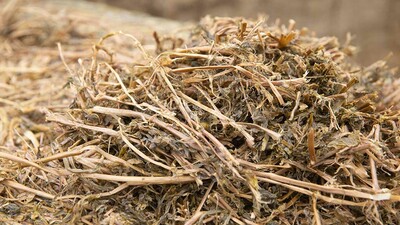
I think we are going to see more pressure on feeding protein.
Carbon seems to be increasingly talked about and we've got to try and be more sustainable where possible and maximising homegrown forage is a key part of that." Overall, the herd receives much less soya than it did before lucerne was introduced.
The winter diet (fresh weight) consists of 20kg of first cut grass, 20kg of maize silage, 10kg of lucerne silage, 3kg of home-grown and rolled barley and 1.5kg soya meal.
Cows also get up to 9kg of a 17% protein cake through the parlour.
The lucerne has also brought the added benefit of allowing straw, which is of low nutritional value, to be taken out of the diet.
"We're getting more quality forage into the cows and more milk from forage.
If you're feeding 1kg of straw, that's probably 2-3kg less silage they're eating," he says.
The scratch factor from lucerne helps milk fat levels, while also aiding rumen buffering capacity.
"It makes the cows a lot more stable.
We're been able to feed higher levels of starch at certain times of the year," he says.
Tips for ensiling lucerne
Naturally low sugars and high buffering capacity means a silage additive is a must when conserving lucerne, says Volac's silage scientist, Philip Jones.
The high protein level in the crop results in buffering, which means high levels of lactic acid need to be produced to drive down the pH as part of fermentation, he says.
At the same time, low sugar levels mean lactic acid producing bugs have less ‘fuel' to work with.
This means there is a higher chance of secondary fermentation and butyric silage.
With this in mind, he advises:
- Striving for high dry matters (DM) to concentrate the sugars in the crop - aim for about 30-40% DM in clamped lucerne and 35-45% DM in baled lucerne.
- Use a homofermentative silage additive such as Lactobacillus plantarum to produce a quick, efficient fermentation, eg. Ecosyl.
- When aerobic stability is a problem, use an additive with an additional heterofermentative strain such as Lactobacillus buchneri, eg. EcoCoo
Financial benefits
Financial benefits
Mr Stroud also believes introducing forage maize into the diet for the first time this winter has aided milk constituents.
He says: "I want to make lucerne and maize the base of our ration all year round and push our grass quality even higher and see where we can get to.".
This should help deliver his ultimate aim of achieving a good balance between litres and solids.
In November, Mr Stroud crunched some numbers to see how the business was performing that month, compared to the previous November - this fits with his ‘measure to manage' approach.
He kept milk and feed prices the same.
His calculations showed he was £3,500 a month better off thanks to better production and reduced feed cost savings.
He thinks including maize in the diet for the first time and continuing to include lucerne, has been the main reason.
"The herd is performing really well and consistently through the year and we are sure it's down to lucerne.
It's a big part of the puzzle," says Mr Stroud, who also thinks regular reseeding and producing better quality grass silage has helped the overall picture.
How lucerne is grown at The Grange
- Crop established end August-early September after wheat.
- A set of discs is used to make a shallow, fine seed bed, which is essential for good establishment.
- Lucerne is broadcast seeded onto the surface.
- Ground is rolled pre-drilling and twice afterwards.
- Slurry is mixed with dirty water and applied after first and second cut at 15t/acre - lucerne loves slurry.
- The new ley is sprayed two to three times in the autumn to get on top of weeds and volunteers - getting on top of weeds early is a priority to ensure lucerne establishes well.
- No spring fertiliser applied.
- A minimum cutting height of four inches is maintained. Cutting too low stops the crop from recovering quickly after mowing.
- The team avoids travelling on the crop when soils are wet as it does not like compaction/wheelings.
- The lucerne lasts over four years and is typically followed by winter wheat.
- Crop typically yields 17t/ acre per year over four cuts












